brakes INFINITI Q60 COUPE 2015 Towing Guide
[x] Cancel search | Manufacturer: INFINITI, Model Year: 2015, Model line: Q60 COUPE, Model: INFINITI Q60 COUPE 2015Pages: 25, PDF Size: 0.42 MB
Page 2 of 25
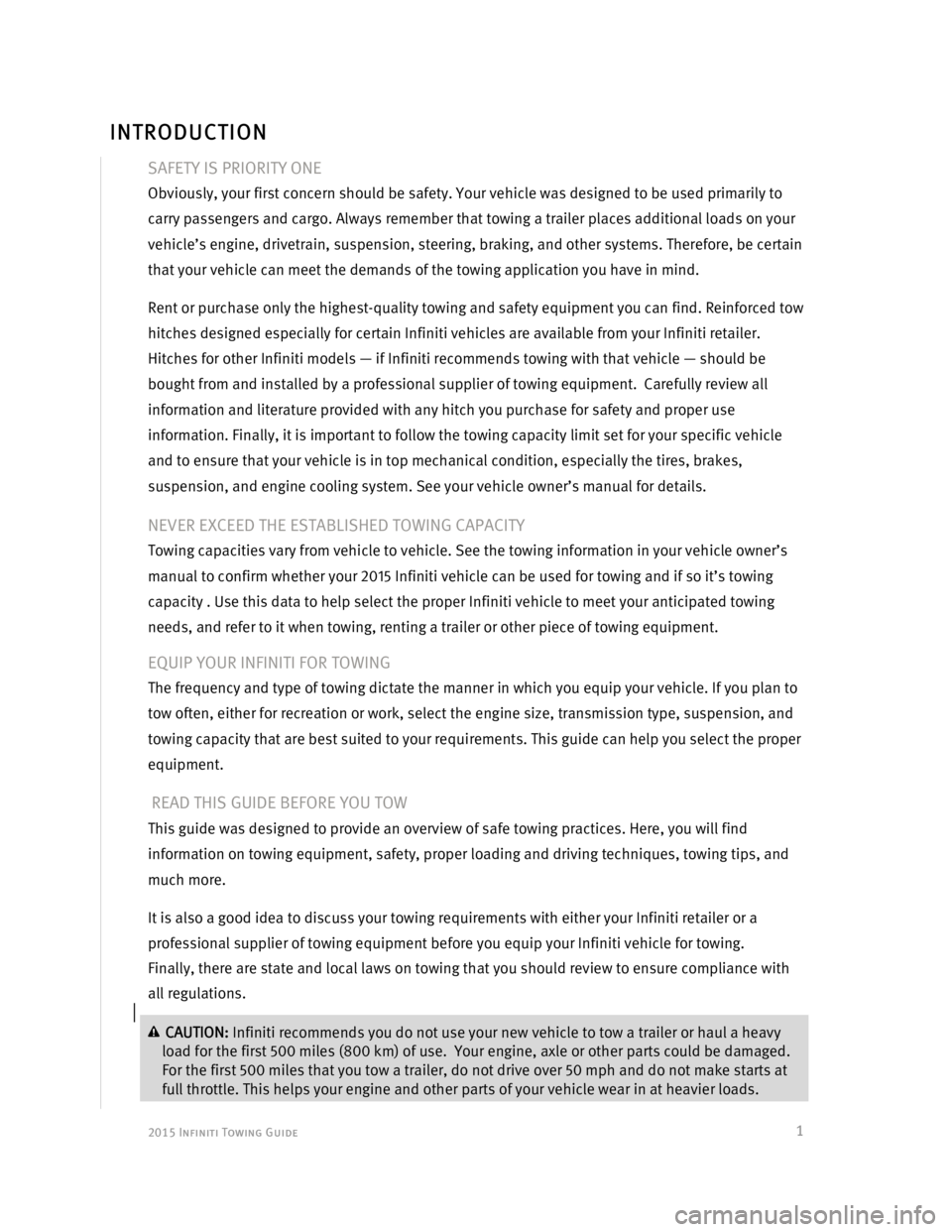
2015 Infiniti Towing Guide
1
SAFETY IS PRIORITY ONE
Obviously, your first concern should be safety. Your vehicle was designed to be used primarily to
carry passengers and cargo. Always remember that towing a trailer places additional loads on your
vehicle’s engine, drivetrain, suspension, steering, braking, and other systems. Therefore, be certain
that your vehicle can meet the demands of the towing application you have in mind.
Rent or purchase only the highest-quality towing and safety equipment you can find. Reinforced tow
hitches designed especially for certain Infiniti vehicles are available from your Infiniti retailer.
Hitches for other Infiniti models — if Infiniti recommends towing with that vehicle — should be
bought from and installed by a professional supplier of towing equipment. Carefully review all
information and literature provided with any hitch you purchase for safety and proper use
information. Finally, it is important to follow the towing capacity limit set for your specific vehicle
and to ensure that your vehicle is in top mechanical condition, especially the tires, brakes,
suspension, and engine cooling system. See your vehicle owner’s manual for details.
NEVER EXCEED THE ESTABLISHED TOWING CAPACITY
Towing capacities vary from vehicle to vehicle. See the towing information in your vehicle owner’s
manual to confirm whether your 2015 Infiniti vehicle can be used for towing and if so it’s towing
capacity . Use this data to help select the proper Infiniti vehicle to meet your anticipated towing
needs, and refer to it when towing, renting a trailer or other piece of towing equipment.
EQUIP YOUR INFINITI FOR TOWING
The frequency and type of towing dictate the manner in which you equip your vehicle. If you plan to
tow often, either for recreation or work, select the engine size, transmission type, suspension, and
towing capacity that are best suited to your requirements. This guide can help you select the proper
equipment.
READ THIS GUIDE BEFORE YOU TOW
This guide was designed to provide an overview of safe towing practices. Here, you will find
information on towing equipment, safety, proper loading and driving techniques, towing tips, and
much more.
It is also a good idea to discuss your towing requirements with either your Infiniti retailer or a
professional supplier of towing equipment before you equip your Infiniti vehicle for towing.
Finally, there are state and local laws on towing that you should review to ensure compliance with
all regulations.
CAUTION: Infiniti recommends you do not use your new vehicle to tow a trailer or haul a heavy
load for the first 500 miles (800 km) of use. Your engine, axle or other parts could be damaged.
For the first 500 miles that you tow a trailer, do not drive over 50 mph and do not make starts at
full throttle. This helps your engine and other parts of your vehicle wear in at heavier loads.
INTRODUCTION
Page 3 of 25
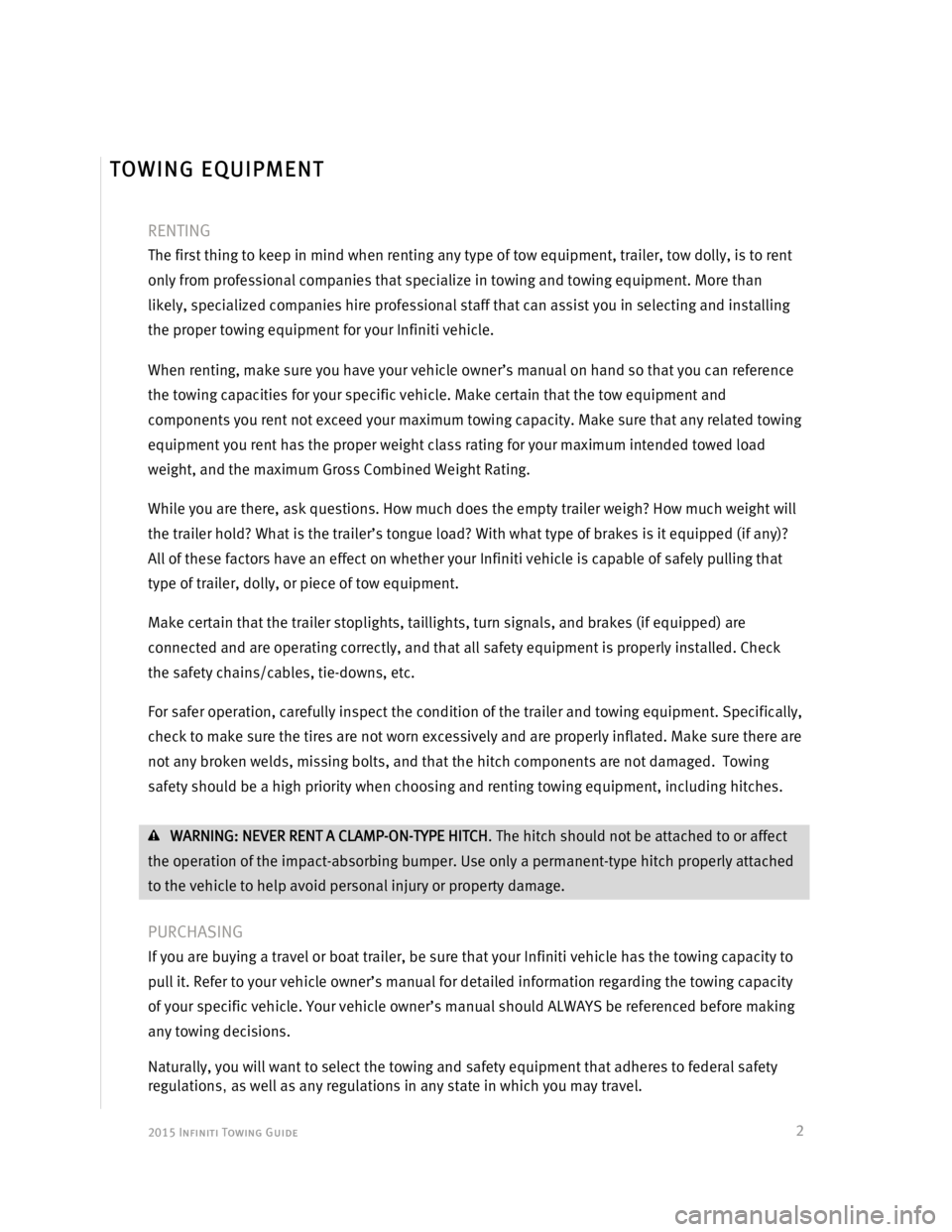
2015 Infiniti Towing Guide
2
RENTING
The first thing to keep in mind when renting any type of tow equipment, trailer, tow dolly, is to rent
only from professional companies that specialize in towing and towing equipment. More than
likely, specialized companies hire professional staff that can assist you in selecting and installing
the proper towing equipment for your Infiniti vehicle.
When renting, make sure you have your vehicle owner’s manual on hand so that you can reference
the towing capacities for your specific vehicle. Make certain that the tow equipment and
components you rent not exceed your maximum towing capacity. Make sure that any related towing
equipment you rent has the proper weight class rating for your maximum intended towed load
weight, and the maximum Gross Combined Weight Rating.
While you are there, ask questions. How much does the empty trailer weigh? How much weight will
the trailer hold? What is the trailer’s tongue load? With what type of brakes is it equipped (if any)?
All of these factors have an effect on whether your Infiniti vehicle is capable of safely pulling that
type of trailer, dolly, or piece of tow equipment.
Make certain that the trailer stoplights, taillights, turn signals, and brakes (if equipped) are
connected and are operating correctly, and that all safety equipment is properly installed. Check
the safety chains/cables, tie-downs, etc.
For safer operation, carefully inspect the condition of the trailer and towing equipment. Specifically,
check to make sure the tires are not worn excessively and are properly inflated. Make sure there are
not any broken welds, missing bolts, and that the hitch components are not damaged. Towing
safety should be a high priority when choosing and renting towing equipment, including hitches.
WARNING: NEVER RENT A CLAMP-ON-TYPE HITCH. The hitch should not be attached to or affect
the operation of the impact-absorbing bumper. Use only a permanent-type hitch properly attached
to the vehicle to help avoid personal injury or property damage.
PURCHASING
If you are buying a travel or boat trailer, be sure that your Infiniti vehicle has the towing capacity to
pull it. Refer to your vehicle owner’s manual for detailed information regarding the towing capacity
of your specific vehicle. Your vehicle owner’s manual should ALWAYS be referenced before making
any towing decisions.
Naturally, you will want to select the towing and safety equipment that adheres to federal safety
regulations, as well as any regulations in any state in which you may travel.
TOWING EQUIPMENT
Page 4 of 25
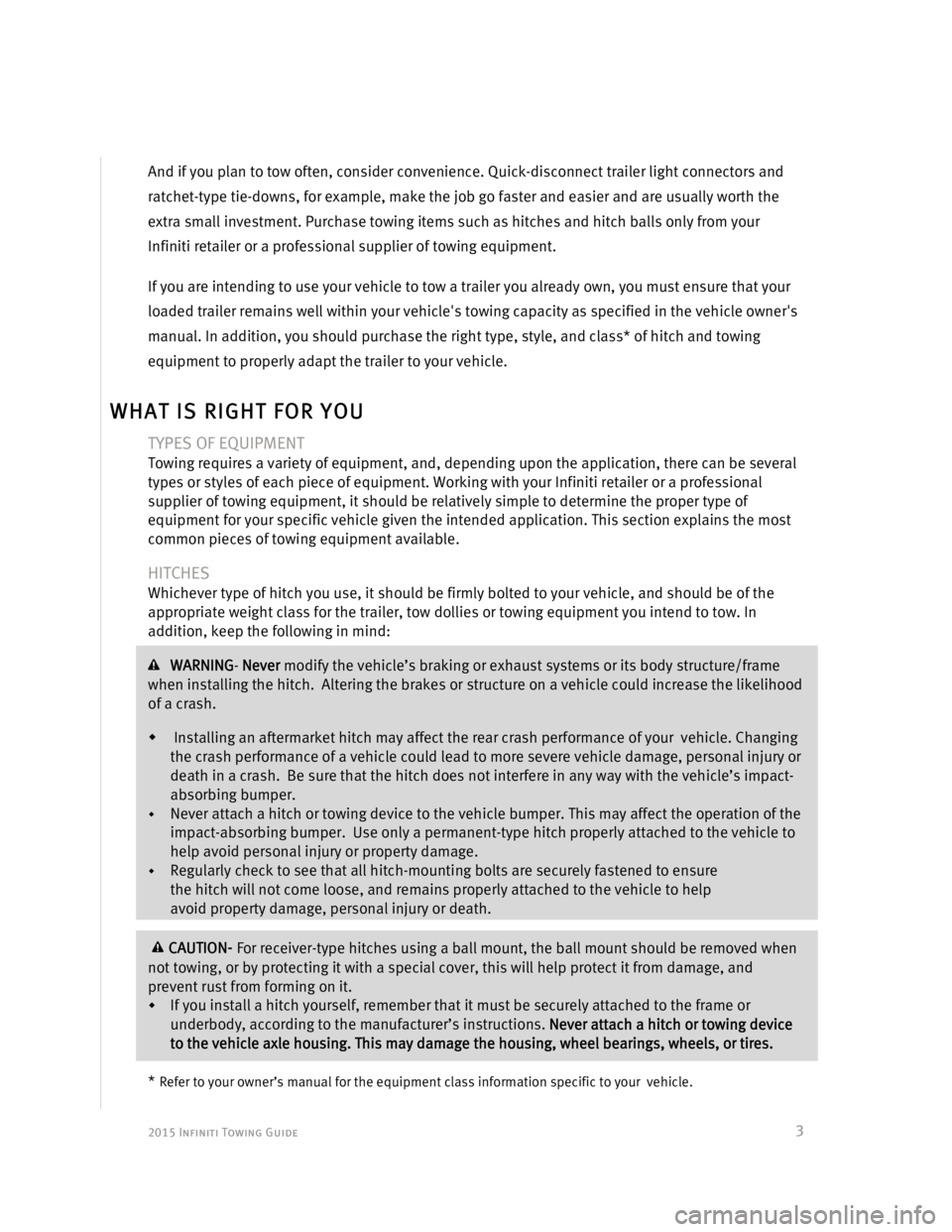
2015 Infiniti Towing Guide
3
And if you plan to tow often, consider convenience. Quick-disconnect trailer light connectors and
ratchet-type tie-downs, for example, make the job go faster and easier and are usually worth the
extra small investment. Purchase towing items such as hitches and hitch balls only from your
Infiniti retailer or a professional supplier of towing equipment.
If you are intending to use your vehicle to tow a trailer you already own, you must ensure that your
loaded trailer remains well within your vehicle's towing capacity as specified in the vehicle owner's
manual. In addition, you should purchase the right type, style, and class* of hitch and towing
equipment to properly adapt the trailer to your vehicle.
TYPES OF EQUIPMENT
Towing requires a variety of equipment, and, depending upon the application, there can be several
types or styles of each piece of equipment. Working with your Infiniti retailer or a professional
supplier of towing equipment, it should be relatively simple to determine the proper type of
equipment for your specific vehicle given the intended application. This section explains the most
common pieces of towing equipment available.
HITCHES
Whichever type of hitch you use, it should be firmly bolted to your vehicle, and should be of the
appropriate weight class for the trailer, tow dollies or towing equipment you intend to tow. In
addition, keep the following in mind:
WARNING- Never modify the vehicle’s braking or exhaust systems or its body structure/frame
when installing the hitch. Altering the brakes or structure on a vehicle could increase the likelihood
of a crash.
Installing an aftermarket hitch may affect the rear crash performance of your vehicle. Changing
the crash performance of a vehicle could lead to more severe vehicle damage, personal injury or
death in a crash. Be sure that the hitch does not interfere in any way with the vehicle’s impact-
absorbing bumper.
Never attach a hitch or towing device to the vehicle bumper. This may affect the operation of the
impact-absorbing bumper. Use only a permanent-type hitch properly attached to the vehicle to
help avoid personal injury or property damage.
Regularly check to see that all hitch-mounting bolts are securely fastened to ensure
the hitch will not come loose, and remains properly attached to the vehicle to help
avoid property damage, personal injury or death.
CAUTION- For receiver-type hitches using a ball mount, the ball mount should be removed when
not towing, or by protecting it with a special cover, this will help protect it from damage, and
prevent rust from forming on it.
If you install a hitch yourself, remember that it must be securely attached to the frame or
underbody, according to the manufacturer’s instructions. Never attach a hitch or towing device
to the vehicle axle housing. This may damage the housing, wheel bearings, wheels, or tires.
*
Refer to your owner’s manual for the equipment class information specific to your vehicle.
WHAT IS RIGHT FOR YOU
Page 6 of 25
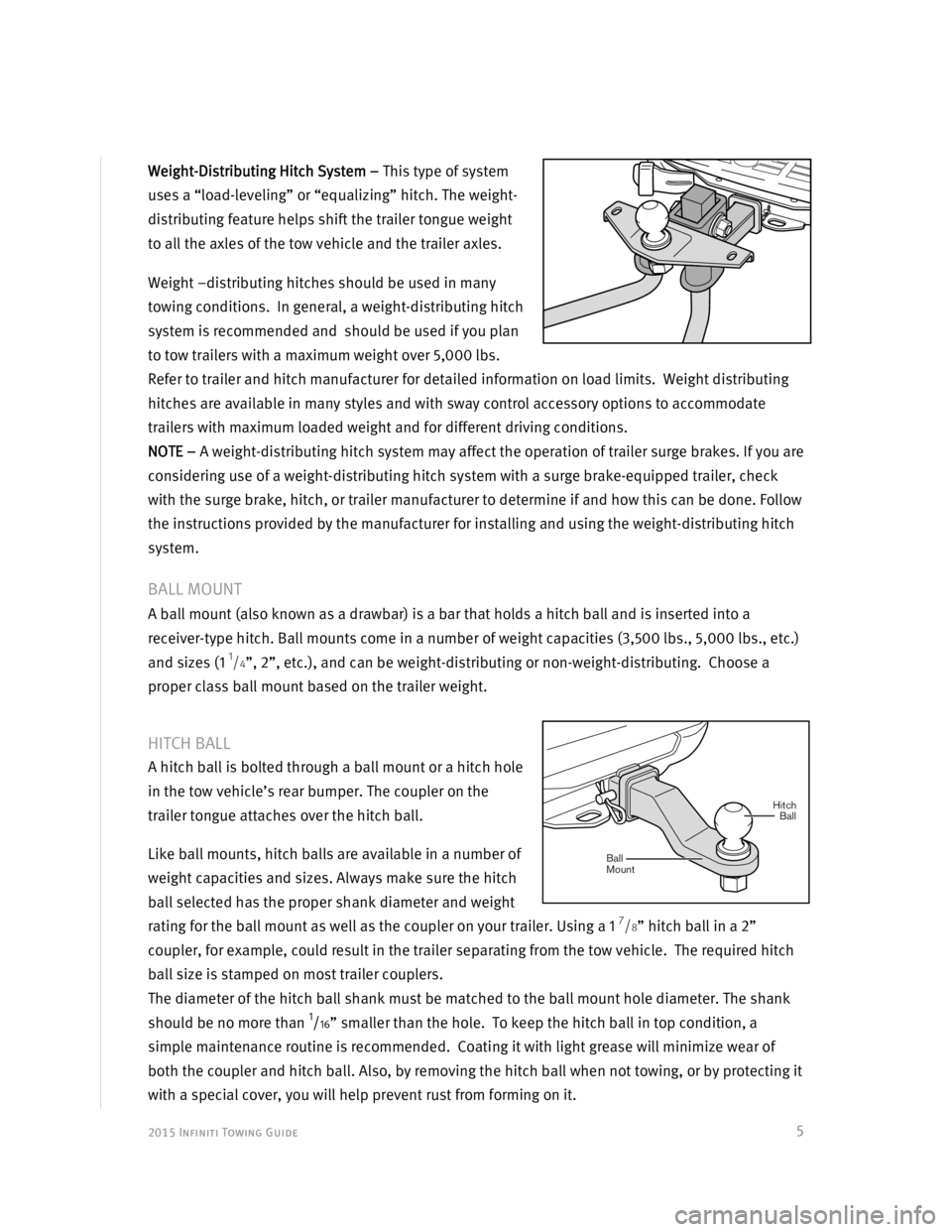
2015 Infiniti Towing Guide
5 Weight-Distributing Hitch System – This type of system
uses a “load-leveling” or “equalizing” hitch. The weight-
distributing feature helps shift the trailer tongue weight
to all the axles of the tow vehicle and the trailer axles.
Weight –distributing hitches should be used in many
towing conditions. In general, a weight-distributing hitch
system is recommended and should be used if you plan
to tow trailers with a maximum weight over 5,000 lbs.
Refer to trailer and hitch manufacturer for detailed information on load limits. Weight distributing
hitches are available in many styles and with sway control accessory options to accommodate
trailers with maximum loaded weight and for different driving conditions.
NOTE – A weight-distributing hitch system may affect the operation of trailer surge brakes. If you are
considering use of a weight-distributing hitch system with a surge brake-equipped trailer, check
with the surge brake, hitch, or trailer manufacturer to determine if and how this can be done. Follow
the instructions provided by the manufacturer for installing and using the weight-distributing hitch
system.
BALL MOUNT
A ball mount (also known as a drawbar) is a bar that holds a hitch ball and is inserted into a
receiver-type hitch. Ball mounts come in a number of weight capacities (3,500 lbs., 5,000 lbs., etc.)
and sizes (1
1/4”, 2”, etc.), and can be weight-distributing or non-weight-distributing. Choose a
proper class ball mount based on the trailer weight.
HITCH BALL
A hitch ball is bolted through a ball mount or a hitch hole
in the tow vehicle’s rear bumper. The coupler on the
trailer tongue attaches over the hitch ball.
Like ball mounts, hitch balls are available in a number of
weight capacities and sizes. Always make sure the hitch
ball selected has the proper shank diameter and weight
rating for the ball mount as well as the coupler on your trailer. Using a 1
7/8” hitch ball in a 2”
coupler, for example, could result in the trailer separating from the tow vehicle. The required hitch
ball size is stamped on most trailer couplers.
The diameter of the hitch ball shank must be matched to the ball mount hole diameter. The shank
should be no more than
1/16” smaller than the hole. To keep the hitch ball in top condition, a
simple maintenance routine is recommended. Coating it with light grease will minimize wear of
both the coupler and hitch ball. Also, by removing the hitch ball when not towing, or by protecting it
with a special cover, you will help prevent rust from forming on it.
Hitch
Mount BallBall
Page 8 of 25
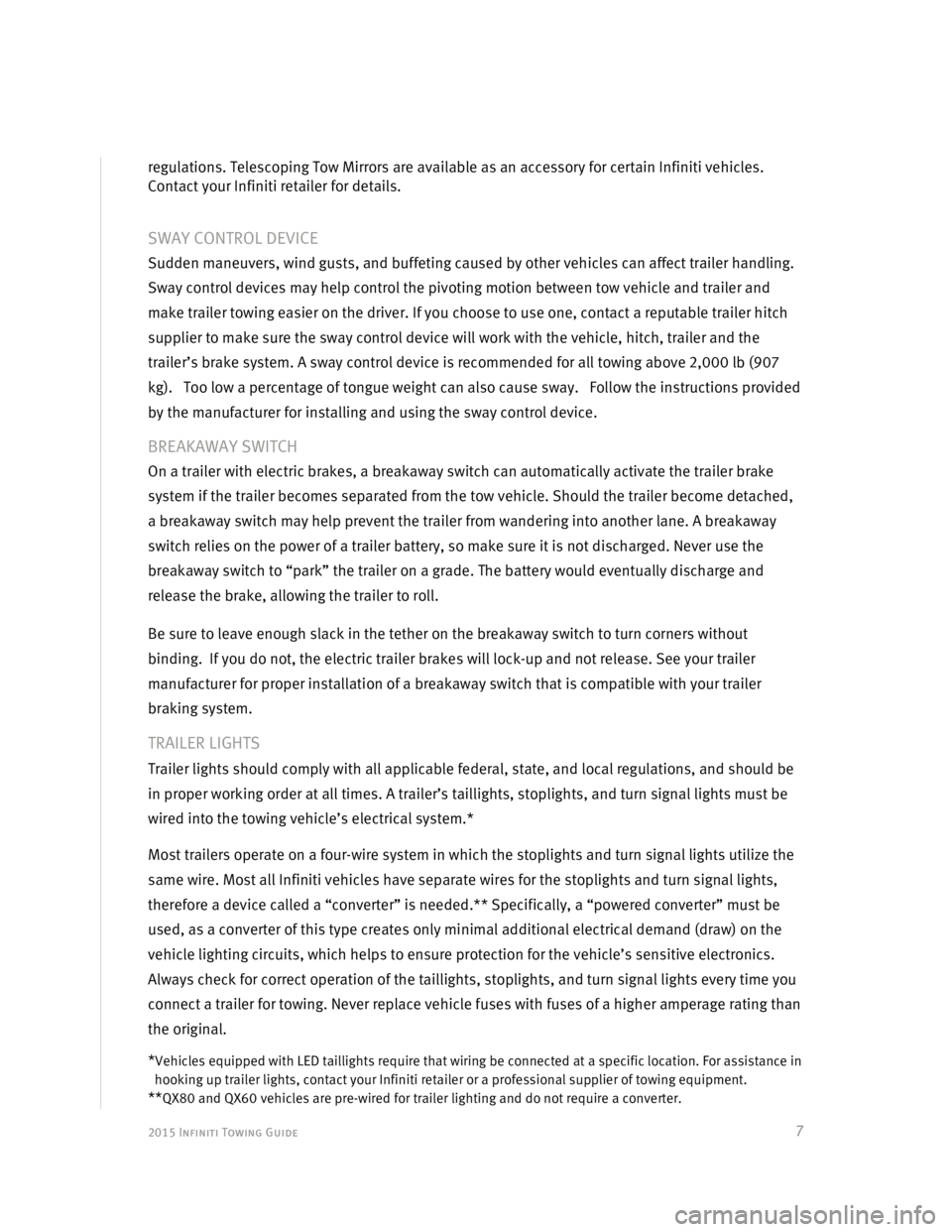
2015 Infiniti Towing Guide
7 regulations. Telescoping Tow Mirrors are available as an accessory for certain Infiniti vehicles.
Contact your Infiniti retailer for details.
SWAY CONTROL DEVICE
Sudden maneuvers, wind gusts, and buffeting caused by other vehicles can affect trailer handling.
Sway control devices may help control the pivoting motion between tow vehicle and trailer and
make trailer towing easier on the driver. If you choose to use one, contact a reputable trailer hitch
supplier to make sure the sway control device will work with the vehicle, hitch, trailer and the
trailer’s brake system. A sway control device is recommended for all towing above 2,000 lb (907
kg). Too low a percentage of tongue weight can also cause sway. Follow the instructions provided
by the manufacturer for installing and using the sway control device.
BREAKAWAY SWITCH
On a trailer with electric brakes, a breakaway switch can automatically activate the trailer brake
system if the trailer becomes separated from the tow vehicle. Should the trailer become detached,
a breakaway switch may help prevent the trailer from wandering into another lane. A breakaway
switch relies on the power of a trailer battery, so make sure it is not discharged. Never use the
breakaway switch to “park” the trailer on a grade. The battery would eventually discharge and
release the brake, allowing the trailer to roll.
Be sure to leave enough slack in the tether on the breakaway switch to turn corners without
binding. If you do not, the electric trailer brakes will lock-up and not release. See your trailer
manufacturer for proper installation of a breakaway switch that is compatible with your trailer
braking system.
TRAILER LIGHTS
Trailer lights should comply with all applicable federal, state, and local regulations, and should be
in proper working order at all times. A trailer’s taillights, stoplights, and turn signal lights must be
wired into the towing vehicle’s electrical system.*
Most trailers operate on a four-wire system in which the stoplights and turn signal lights utilize the
same wire. Most all Infiniti vehicles have separate wires for the stoplights and turn signal lights,
therefore a device called a “converter” is needed.** Specifically, a “powered converter” must be
used, as a converter of this type creates only minimal additional electrical demand (draw) on the
vehicle lighting circuits, which helps to ensure protection for the vehicle’s sensitive electronics.
Always check for correct operation of the taillights, stoplights, and turn signal lights every time you
connect a trailer for towing. Never replace vehicle fuses with fuses of a higher amperage rating than
the original.
*Vehicles equipped with LED taillights require that wiring be connected at a specific location. For assistance in
hooking up trailer lights, contact your Infiniti retailer or a professional supplier of towing equipment.
**QX80 and QX60 vehicles are pre-wired for trailer lighting and do not require a converter.
Page 9 of 25
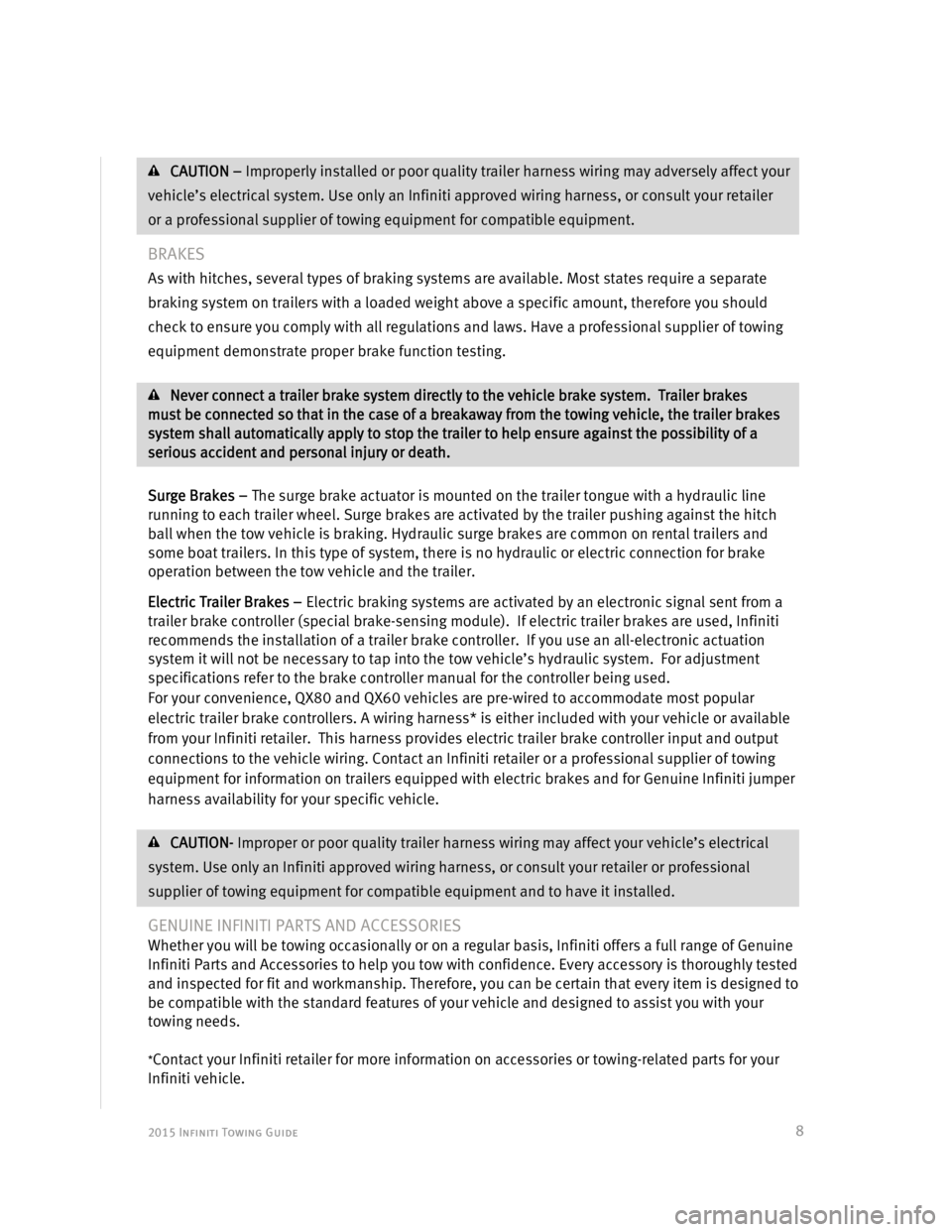
2015 Infiniti Towing Guide
8
CAUTION – Improperly installed or poor quality trailer harness wiring may adversely affect your
vehicle’s electrical system. Use only an Infiniti approved wiring harness, or consult your retailer
or a professional supplier of towing equipment for compatible equipment.
BRAKES
As with hitches, several types of braking systems are available. Most states require a separate
braking system on trailers with a loaded weight above a specific amount, therefore you should
check to ensure you comply with all regulations and laws. Have a professional supplier of towing
equipment demonstrate proper brake function testing.
Never connect a trailer brake system directly to the vehicle brake system. Trailer brakes
must be connected so that in the case of a breakaway from the towing vehicle, the trailer brakes
system shall automatically apply to stop the trailer to help ensure against the possibility of a
serious accident and personal injury or death.
Surge Brakes – The surge brake actuator is mounted on the trailer tongue with a hydraulic line
running to each trailer wheel. Surge brakes are activated by the trailer pushing against the hitch
ball when the tow vehicle is braking. Hydraulic surge brakes are common on rental trailers and
some boat trailers. In this type of system, there is no hydraulic or electric connection for brake
operation between the tow vehicle and the trailer.
Electric Trailer Brakes – Electric braking systems are activated by an electronic signal sent from a
trailer brake controller (special brake-sensing module). If electric trailer brakes are used, Infiniti
recommends the installation of a trailer brake controller. If you use an all-electronic actuation
system it will not be necessary to tap into the tow vehicle’s hydraulic system. For adjustment
specifications refer to the brake controller manual for the controller being used.
For your convenience, QX80 and QX60 vehicles are pre-wired to accommodate most popular
electric trailer brake controllers. A wiring harness* is either included with your vehicle or available
from your Infiniti retailer. This harness provides electric trailer brake controller input and output
connections to the vehicle wiring. Contact an Infiniti retailer or a professional supplier of towing
equipment for information on trailers equipped with electric brakes and for Genuine Infiniti jumper
harness availability for your specific vehicle.
CAUTION- Improper or poor quality trailer harness wiring may affect your vehicle’s electrical
system. Use only an Infiniti approved wiring harness, or consult your retailer or professional
supplier of towing equipment for compatible equipment and to have it installed.
GENUINE INFINITI PARTS AND ACCESSORIES
Whether you will be towing occasionally or on a regular basis, Infiniti offers a full range of Genuine
Infiniti Parts and Accessories to help you tow with confidence. Every accessory is thoroughly tested
and inspected for fit and workmanship. Therefore, you can be certain that every item is designed to
be compatible with the standard features of your vehicle and designed to assist you with your
towing needs.
*Contact your Infiniti retailer for more information on accessories or towing-related parts for your
Infiniti vehicle.
Page 14 of 25
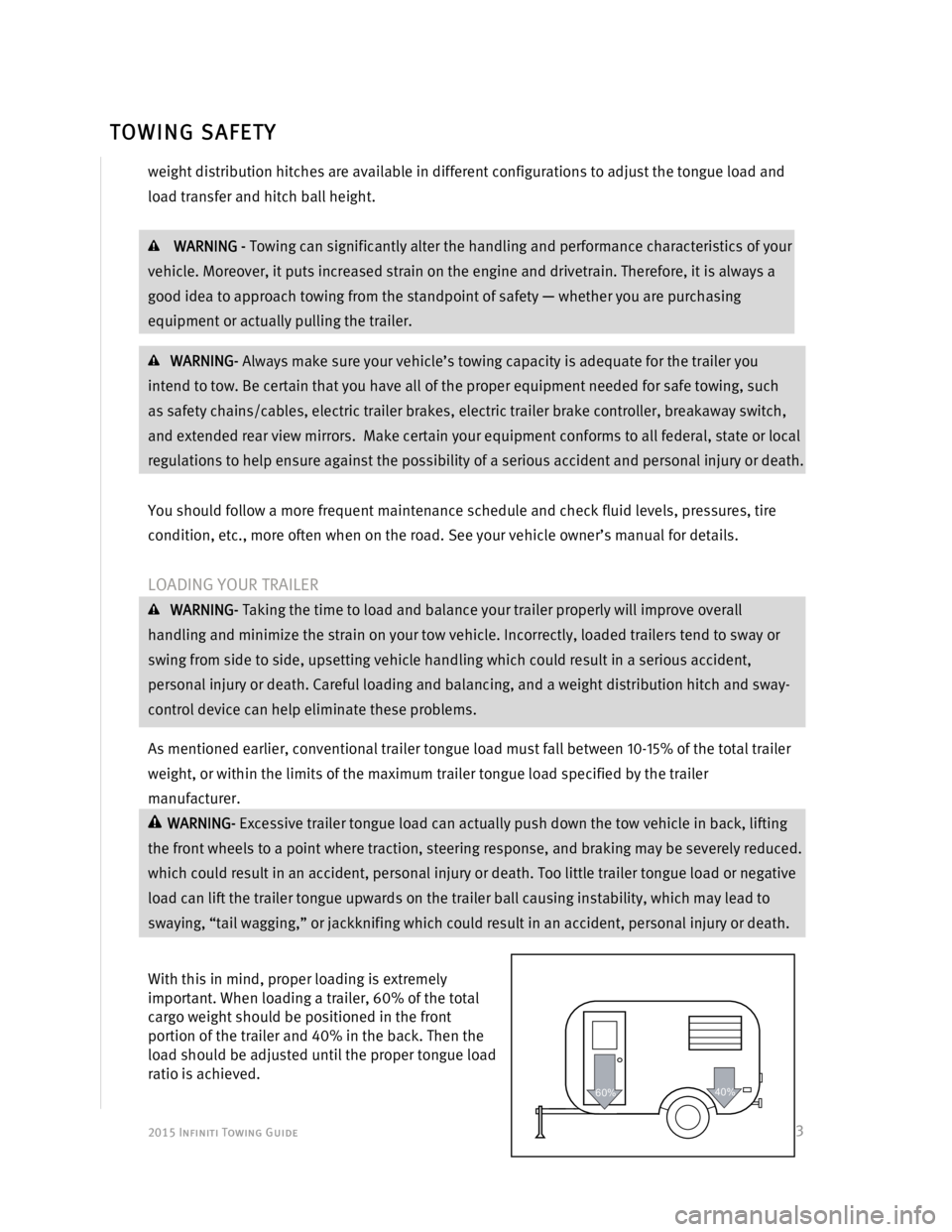
2015 Infiniti Towing Guide
13
weight distribution hitches are available in different configurations to adjust the tongue load and
load transfer and hitch ball height.
WARNING - Towing can significantly alter the handling and performance characteristics of your
vehicle. Moreover, it puts increased strain on the engine and drivetrain. Therefore, it is always a
good idea to approach towing from the standpoint of safety — whether you are purchasing
equipment or actually pulling the trailer.
WARNING- Always make sure your vehicle’s towing capacity is adequate for the trailer you
intend to tow. Be certain that you have all of the proper equipment needed for safe towing, such
as safety chains/cables, electric trailer brakes, electric trailer brake controller, breakaway switch,
and extended rear view mirrors. Make certain your equipment conforms to all federal, state or local
regulations to help ensure against the possibility of a serious accident and personal injury or death.
You should follow a more frequent maintenance schedule and check fluid levels, pressures, tire
condition, etc., more often when on the road. See your vehicle owner’s manual for details.
LOADING YOUR TRAILER
WARNING- Taking the time to load and balance your trailer properly will improve overall
handling and minimize the strain on your tow vehicle. Incorrectly, loaded trailers tend to sway or
swing from side to side, upsetting vehicle handling which could result in a serious accident,
personal injury or death. Careful loading and balancing, and a weight distribution hitch and sway-
control device can help eliminate these problems.
As mentioned earlier, conventional trailer tongue load must fall between 10-15% of the total trailer
weight, or within the limits of the maximum trailer tongue load specified by the trailer
manufacturer.
WARNING- Excessive trailer tongue load can actually push down the tow vehicle in back, lifting
the front wheels to a point where traction, steering response, and braking may be severely reduced.
which could result in an accident, personal injury or death. Too little trailer tongue load or negative
load can lift the trailer tongue upwards on the trailer ball causing instability, which may lead to
swaying, “tail wagging,” or jackknifing which could result in an accident, personal injury or death.
With this in mind, proper loading is extremely
important. When loading a trailer, 60% of the total
cargo weight should be positioned in the front
portion of the trailer and 40% in the back. Then the
load should be adjusted until the proper tongue load
ratio is achieved.
60%40%
TOWING SAFETY
Page 15 of 25
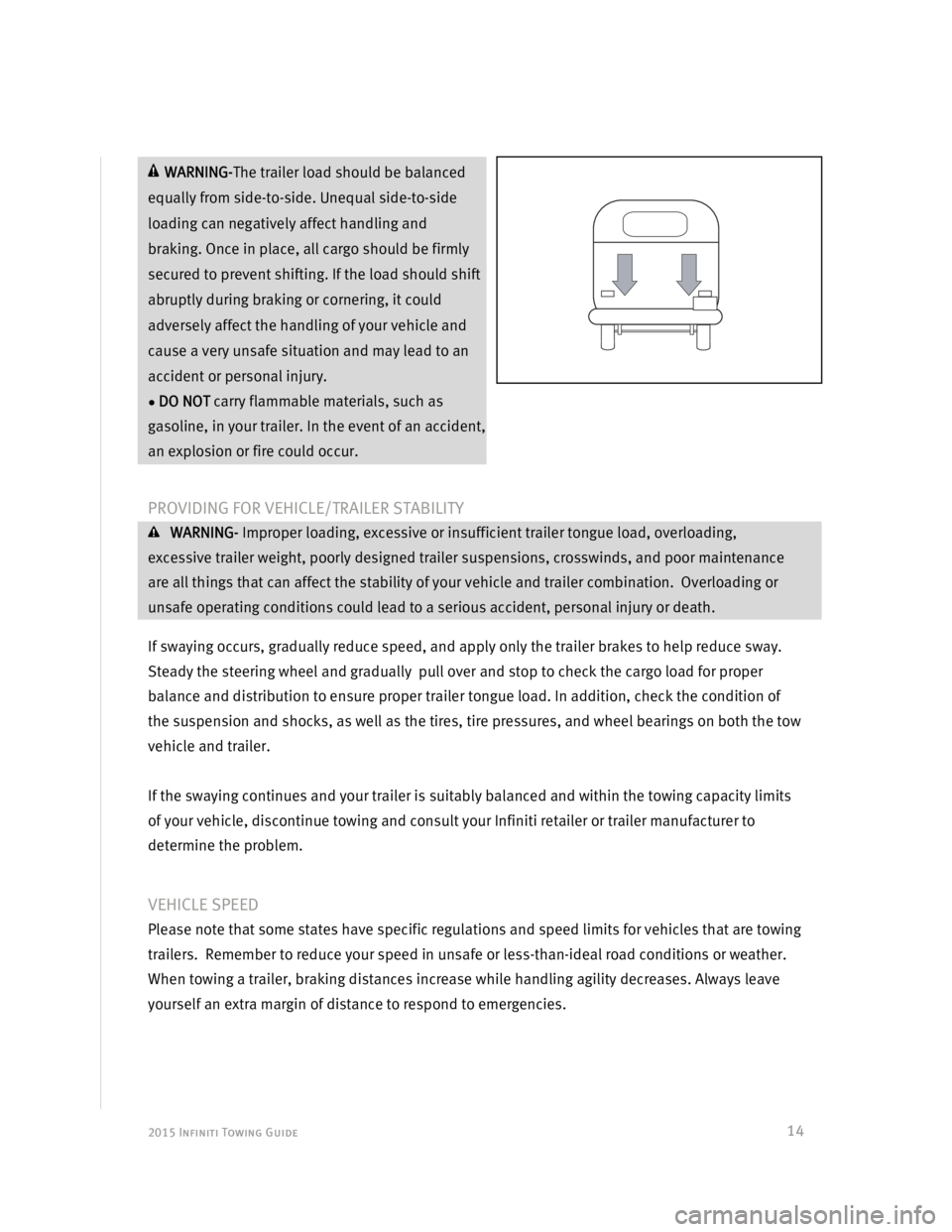
2015 Infiniti Towing Guide
14
WARNING-The trailer load should be balanced
equally from side-to-side. Unequal side-to-side
loading can negatively affect handling and
braking. Once in place, all cargo should be firmly
secured to prevent shifting. If the load should shift
abruptly during braking or cornering, it could
adversely affect the handling of your vehicle and
cause a very unsafe situation and may lead to an
accident or personal injury.
● DO NOT carry flammable materials, such as
gasoline, in your trailer. In the event of an accident,
an explosion or fire could occur.
PROVIDING FOR VEHICLE/TRAILER STABILITY
WARNING- Improper loading, excessive or insufficient trailer tongue load, overloading,
excessive trailer weight, poorly designed trailer suspensions, crosswinds, and poor maintenance
are all things that can affect the stability of your vehicle and trailer combination. Overloading or
unsafe operating conditions could lead to a serious accident, personal injury or death.
If swaying occurs, gradually reduce speed, and apply only the trailer brakes to help reduce sway.
Steady the steering wheel and gradually pull over and stop to check the cargo load for proper
balance and distribution to ensure proper trailer tongue load. In addition, check the condition of
the suspension and shocks, as well as the tires, tire pressures, and wheel bearings on both the tow
vehicle and trailer.
If the swaying continues and your trailer is suitably balanced and within the towing capacity limits
of your vehicle, discontinue towing and consult your Infiniti retailer or trailer manufacturer to
determine the problem.
VEHICLE SPEED
Please note that some states have specific regulations and speed limits for vehicles that are towing
trailers. Remember to reduce your speed in unsafe or less-than-ideal road conditions or weather.
When towing a trailer, braking distances increase while handling agility decreases. Always leave
yourself an extra margin of distance to respond to emergencies.
Page 16 of 25
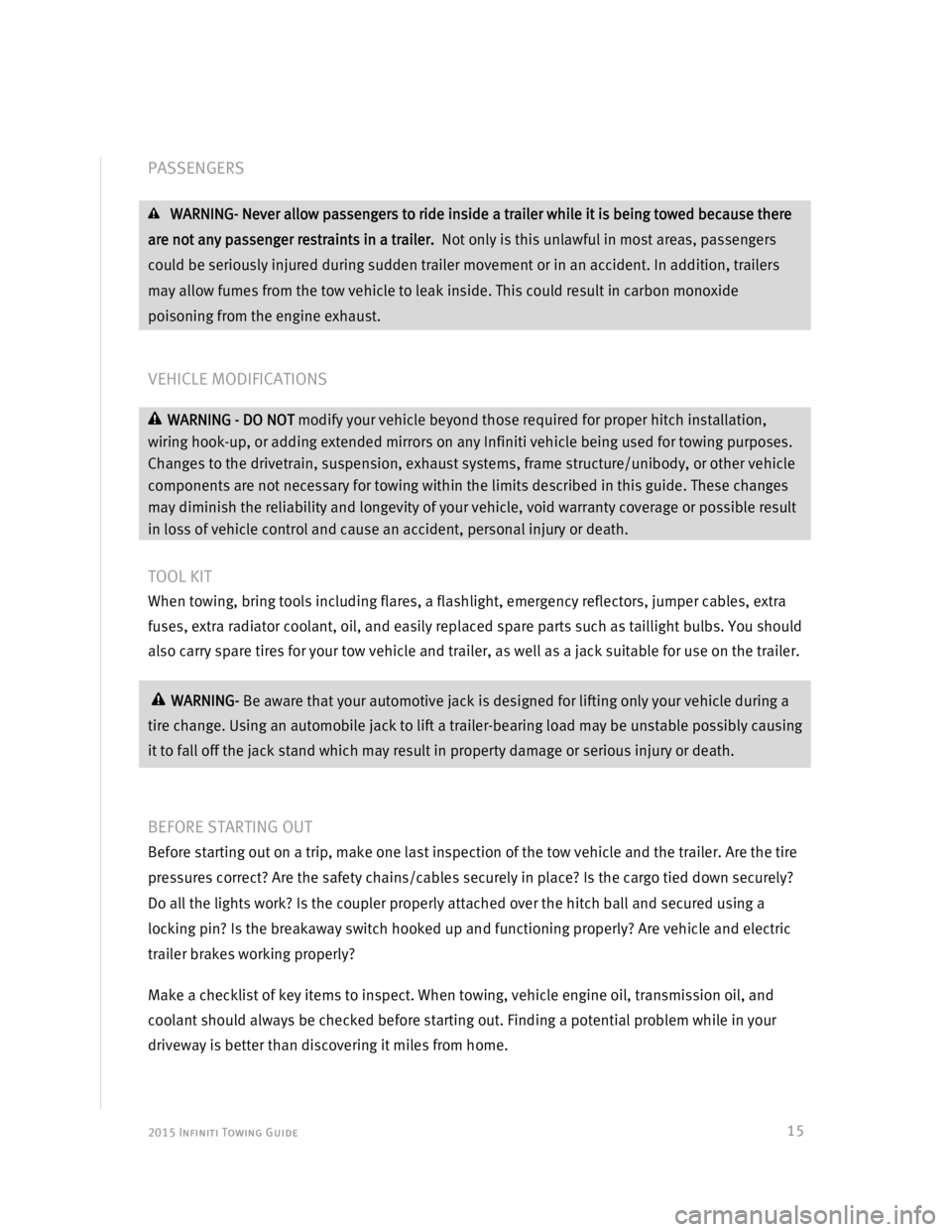
2015 Infiniti Towing Guide
15
PASSENGERS
WARNING- Never allow passengers to ride inside a trailer while it is being towed because there
are not any passenger restraints in a trailer. Not only is this unlawful in most areas, passengers
could be seriously injured during sudden trailer movement or in an accident. In addition, trailers
may allow fumes from the tow vehicle to leak inside. This could result in carbon monoxide
poisoning from the engine exhaust.
VEHICLE MODIFICATIONS
WARNING - DO NOT modify your vehicle beyond those required for proper hitch installation,
wiring hook-up, or adding extended mirrors on any Infiniti vehicle being used for towing purposes.
Changes to the drivetrain, suspension, exhaust systems, frame structure/unibody, or other vehicle
components are not necessary for towing within the limits described in this guide. These changes
may diminish the reliability and longevity of your vehicle, void warranty coverage or possible result
in loss of vehicle control and cause an accident, personal injury or death.
TOOL KIT
When towing, bring tools including flares, a flashlight, emergency reflectors, jumper cables, extra
fuses, extra radiator coolant, oil, and easily replaced spare parts such as taillight bulbs. You should
also carry spare tires for your tow vehicle and trailer, as well as a jack suitable for use on the trailer.
WARNING- Be aware that your automotive jack is designed for lifting only your vehicle during a
tire change. Using an automobile jack to lift a trailer-bearing load may be unstable possibly causing
it to fall off the jack stand which may result in property damage or serious injury or death.
BEFORE STARTING OUT
Before starting out on a trip, make one last inspection of the tow vehicle and the trailer. Are the tire
pressures correct? Are the safety chains/cables securely in place? Is the cargo tied down securely?
Do all the lights work? Is the coupler properly attached over the hitch ball and secured using a
locking pin? Is the breakaway switch hooked up and functioning properly? Are vehicle and electric
trailer brakes working properly?
Make a checklist of key items to inspect. When towing, vehicle engine oil, transmission oil, and
coolant should always be checked before starting out. Finding a potential problem while in your
driveway is better than discovering it miles from home.
Page 17 of 25
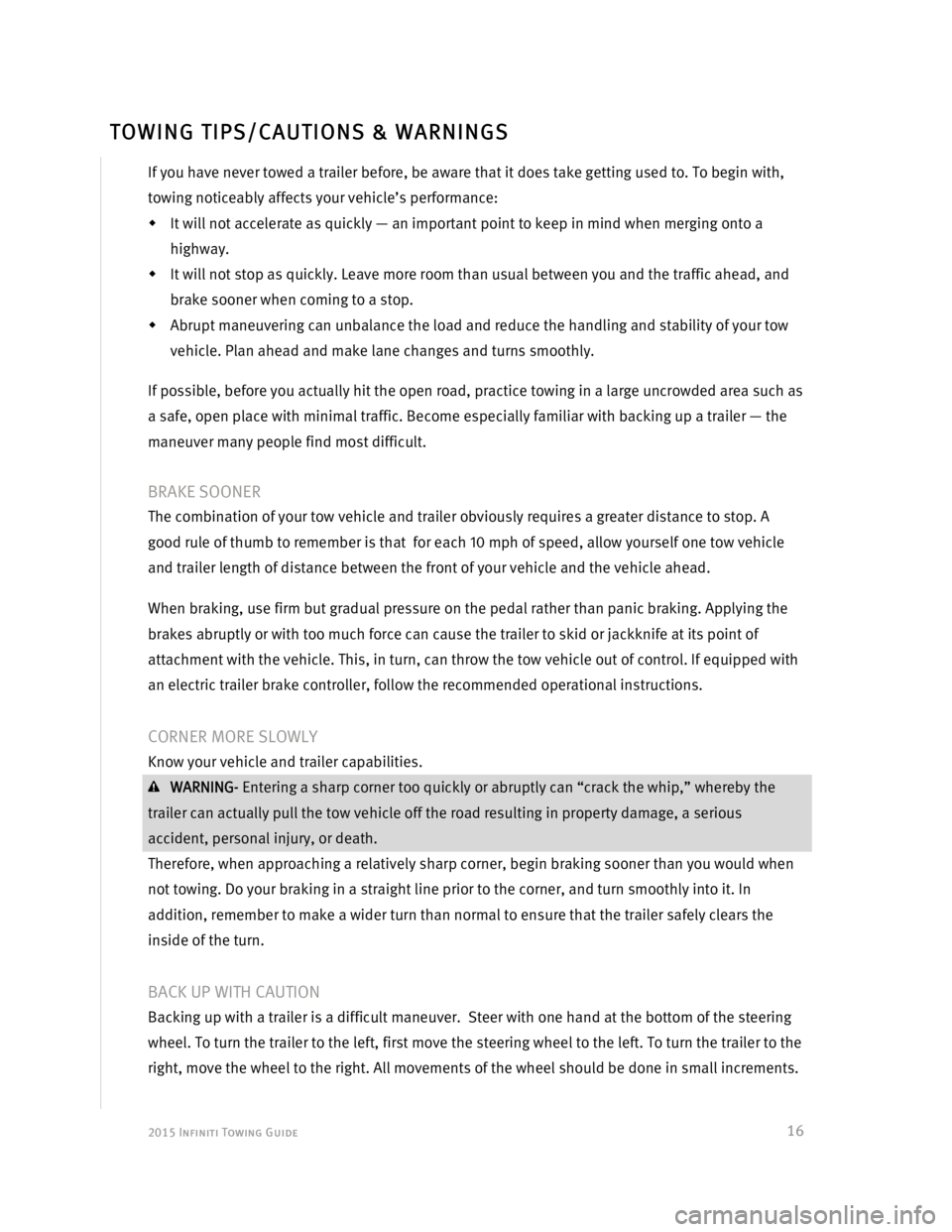
2015 Infiniti Towing Guide
16
If you have never towed a trailer before, be aware that it does take getting used to. To begin with,
towing noticeably affects your vehicle’s performance:
It will not accelerate as quickly — an important point to keep in mind when merging onto a
highway.
It will not stop as quickly. Leave more room than usual between you and the traffic ahead, and
brake sooner when coming to a stop.
Abrupt maneuvering can unbalance the load and reduce the handling and stability of your tow
vehicle. Plan ahead and make lane changes and turns smoothly.
If possible, before you actually hit the open road, practice towing in a large uncrowded area such as
a safe, open place with minimal traffic. Become especially familiar with backing up a trailer — the
maneuver many people find most difficult.
BRAKE SOONER
The combination of your tow vehicle and trailer obviously requires a greater distance to stop. A
good rule of thumb to remember is that for each 10 mph of speed, allow yourself one tow vehicle
and trailer length of distance between the front of your vehicle and the vehicle ahead.
When braking, use firm but gradual pressure on the pedal rather than panic braking. Applying the
brakes abruptly or with too much force can cause the trailer to skid or jackknife at its point of
attachment with the vehicle. This, in turn, can throw the tow vehicle out of control. If equipped with
an electric trailer brake controller, follow the recommended operational instructions.
CORNER MORE SLOWLY
Know your vehicle and trailer capabilities.
WARNING- Entering a sharp corner too quickly or abruptly can “crack the whip,” whereby the
trailer can actually pull the tow vehicle off the road resulting in property damage, a serious
accident, personal injury, or death.
Therefore, when approaching a relatively sharp corner, begin braking sooner than you would when
not towing. Do your braking in a straight line prior to the corner, and turn smoothly into it. In
addition, remember to make a wider turn than normal to ensure that the trailer safely clears the
inside of the turn.
BACK UP WITH CAUTION
Backing up with a trailer is a difficult maneuver. Steer with one hand at the bottom of the steering
wheel. To turn the trailer to the left, first move the steering wheel to the left. To turn the trailer to the
right, move the wheel to the right. All movements of the wheel should be done in small increments.
TOWING TIPS/CAUTIONS & WARNINGS